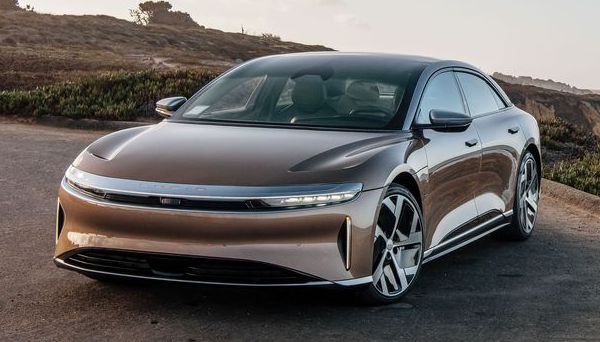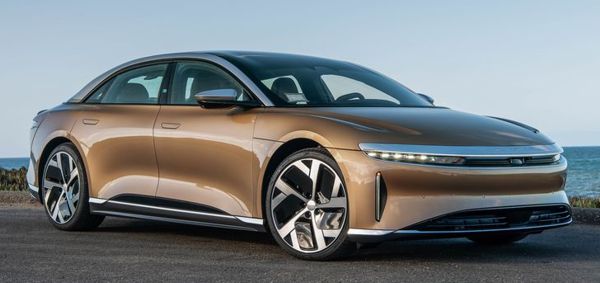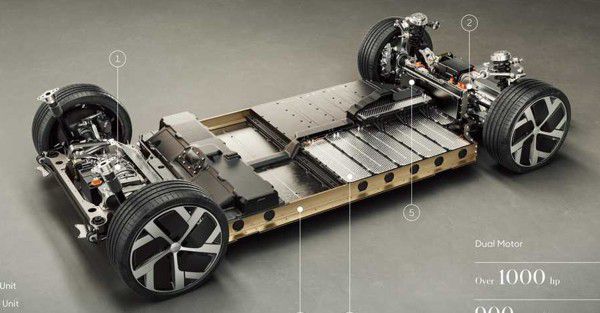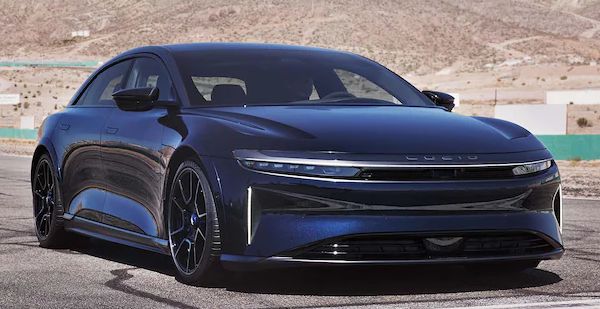Published
on 17
Dec 2021
|
All rights reserved.
|
|
|

|
|
The
Siicone Valley startup stuns the world by beating Mercedes in its own
game.
|
|
I
remember the
production Air was unveiled on September 9th last year, the same day as
the world debut of Maserati MC20.
The Maserati should have been the headline that day. It was sexy. It
was exotic. It was the Italian brand's first in-house-built supercar in
half a century. Somehow, I found the electric luxury saloon from a
Silicon Valley
startup more interesting. It is not about
performance or shape, although this car doesn't lack both, but the
progress and vision it shows in technology and design. While the
Maserati is a new car born out of the old template, the Lucid shows us
the future of motoring world.
Lucid Motors, originally named Atieva, was founded in 2007 as a
supplier of EV components. In 2013, it poached the chief engineer of
Tesla Model S (also ex-Jaguar and Lotus engineer), Peter Rawlinson, to
lead the development of its own EV. A couple of years later, the man
who penned the current Mazda MX-5, Derek Jenkins, joined Lucid as chief
designer. The first prototype of Air was unveiled to the public in
2016, but the development took longer than expected due to its
ambitious targets, and the company went into financial trouble.
Fortunately, it was saved by the Saudi investment fund, otherwise this
amazing car would have had no chance to see the light of production.

|
|
Fastest
model does 0-60 in a Bugatti-rivalling 2.5 seconds. Longest range one
achieves 520 miles. This is the state of the art EV tech.
|
|
The production
car keeps most of its promises, especially the futuristic styling and
high level of finish. It is truly a beautiful design. Low, wide, sleek
and elegant in details. Its full-width chrome panel at the leading edge
of the bonnet and the hidden LED headlights using micro-lens
technology, in combination with a smooth front bumper makes the face
remarkably sleek and futuristic, almost like a bullet train. The side
profile has hints of Audi - and I mean Audi in its golden era during
the 1990s, not today's Audi. The rear has a wraparound screen, a very
short deck and clamshell boot lid, radical for a large luxury saloon.
It is also very slippery. Its Cd is only 0.21, trailing only the new
Mercedes EQS.
The Air occupies the same road space as Tesla Model S, measuring almost
5 meters long and 2 meters wide, but it is 25mm lower at only 1410mm.
That’s a massive 102mm lower than the Mercedes EQS, no wonder it looks
so much sleeker. This helps it to boost energy efficiency when cruising
on highway. While the big Tesla was designed like a conventional car,
the Lucid takes full advantage of the packaging efficiency of EV,
employing an extremely short front overhang and front compartment. At
the back, although the extremely short trunk hints at a hatchback, it
is actually a 3-box saloon. Ditching tailgate helps it to achieve
higher chassis rigidity than its Tesla rival.

|
|
Avantgarde,
low, sleek and tasteful, so much better looking than any large luxury
cars I can think of.
|
|
Benefited by the experience of developing Model S, Rawlinson pushes
both energy and
space efficiency of this car to a higher level. The in-house-developed
electric motor is more power-densed than rivals. Completed with
transmission, differential and inverter in a single unit, it weighs
only 74kg, is extremely compact yet can produce up to 670hp, returning
a power-to-weight ratio nearly 3 times that of Tesla. The
flagship Performance model has one such power unit at each axle for a
total output of 1111 horsepower, making it the hypercar among large
sedans. It is good for 0-60 mph in a Bugatti-rivalling 2.5 seconds and
tops a regulated speed of 168 mph. Lesser models offer
933 hp (Dream), 800 hp (GT) or 620 hp (Touring) with the twin-motor
setup, while single-motor base model (Pure) still manages a respectable
480 hp and 4.2 seconds 0-60 mph sprint. All models are fast.
What makes possible this superior power density is the use of 924V
electrical system, which demands lower current hence narrower windings.
Narrower windings allow the motors to be made smaller, so they protrude
less into usable space. As a result, the Air offers significantly more
luggage space
than Model S or just about any large luxury cars – 739 liters in total,
including a 280-liter frunk. Moreover, the clamshell boot lid gives
access to a wide and low opening, making loading easier than ever.

|
|
More
battery capacity than anyone else, yet able to carve out the rear
footwell for passenger comfort.
|
|
Like Porsche
Taycan but unlike Tesla or Mercedes EQS, the floorpan is not exactly a
skateboard. Its battery, arranged in 22 modules in maximum
configuration, is placed on
the floorpan and
partly under the rear seat but not in the area of rear passenger
footwell, so it allows the rear seat to be mounted lower and enables
that remarkably low roof line, yet the rear passengers don't need to
pull their feet up like the case of EQS. Maximum battery capacity is
113kWh, eclipsing
Tesla's 100kWh and Mercedes' 108kWh. This gives the car a maximum range
of 520 miles,
knocking out the Tesla's 405 miles or Mercedes' 340 miles easily (all
are EPA figures, so should be close to real-world performance). Mind
you, we are talking about the
longest range model, but the 1111hp Performance model still good for
471 miles on 19-inch wheels or 451 miles on 21-inch items. Obviously,
the Air not only offers the largest battery on the market but it also
uses energy more
efficiently than any other rivals.
Charging performance is also superior. Thanks to using 924V /
300kW DC charger, versus 480V / 150-250kW of Tesla, 400V / 200kW of
Mercedes or 800V / 270kW of
Porsche, the Air is able to get 300 miles worth of electric juice in
just 20 minutes. No matter how you measure, the electrical architecture
of Lucid is right at the top of the game. This is the state of the art
EV technology.

|
|
Drag
coefficient is just 0.21, helping it to achieve class-leading energy
efficiency.
|
|
Inevitably,
for all its superior technology and specifications, the Air demands
substantial money. Prices start from $80,000 for the single-motor and
smaller battery base model, rising to an eye-watering $170,000 for the
Performance flagship, while Touring and GT command $95,000 and
$140,000, respectively. These are Mercedes EQS money. Can the
American startup really challenge
Mercedes in the luxury rank?
On the Road
It is hard not to love the Air from its appearance. Avantgarde, low,
sleek and tasteful, a true 4-door GT shape. It is so much better
looking than any large luxury cars I can think of, especially beside
the tall and banana-shaped EQS.
Its interior is also more tastefully styled, with a hint of
Scandinavian design. Yes, the materials, the fit and finish, the
switchgears, the sound system and the seats might not be as great as
Mercedes or Audi – after all, Lucid is a startup aiming to build only
20,000 cars in the first full year of production – but it is still
trimmed with very nice materials, including wood, leather, Alcantara,
alloy and fabric made of recycled plastics, at least on more expensive
models. The Air shows none of the quality shortfalls that made Tesla
notorious. Even for a car costing so much money, you won’t feel
shortchanged.

|
|
Tastefully
styled interior has a hint of Scandinavian design, with build quality
to match.
|
|
Despite the
low roofline, the Air feels, well, airy inside, thanks to a panoramic
glass roof that extends seamlessly from the windscreen. Yes, getting
into the cabin is a little bit difficult due to the lower door aperture
and thick roof rails – the latter are made of aluminum instead of
steel, so they need to be thicker to deliver the same strength – but
once inside, you will find plenty of headroom front and rear – the
latter is better than EQS. Rear legroom is generous. Although like the
EQS there is no space under the front seats to rest your feet, at least
the footwell is deep enough to let your knees rest naturally. Up front,
the driver enjoys good forward view thanks to a slim dashboard and low
cowl. Facing him is a huge, 34-inch curved display which does the work
of instrumentation and sat nav. Other functions are controlled at the
touchscreen at center console. Mercedes’ MBUX infotainment system is
more advanced, but Lucid’s is intuitive enough and leaves some physical
switches for controlling HVAC and audio volume.
Cruising on motorway, the Air is not quite as refined as the EQS. While
Mercedes does the best job in insulating all noise sources from the
cabin, in the Lucid you can hear more wind noise from the A-pillars,
more tire roar from the Pirelli P-Zeros and some motor whine – there is
no synthesized noise playing from the speakers to mask the motor whine
either. However, neither noises are intrusive. Likewise, the suspension
with adaptive dampers rides smoothly, but not quite as pillowy as
Mercedes’ air suspension.

|
|
Accommodates
like an S-class inside, plus an extra trunk.
|
|
However, the
smoothness of electric powertrain is beyond doubt, thanks in part to
the lack of gearchange. The acceleration is simply incredible. 0-60 mph
in 2.5 seconds, quarter mile is done in 9.9 seconds, it makes any AMGs,
M-cars or Panamera laughable. Even the lesser, 800hp GT model is good
for 0-60 in just over 3 seconds. The Air is not engineered to be a true
sports sedan. It’s more an S-class rival than an AMG-killer, but it
achieves supercar performance so effortlessly, all the while without
the noise, harshness and drama of sports sedans.
Riding on skinny low-rolling resistance tires, it does not offer the
same roadholding and braking performance as an AMG E63 or M5, of
course, but for a large luxury car that offers a supple ride, its
handling is unreasonably good. The steering has true feedback. The
aluminum monocoque chassis, reinforced by the battery casing, feels
solid. The 50:50 balance and low center of gravity keeps its mass in
check, lets it corner stably, fluently and predictably. Even the
brakes, actuated hydraulically rather than by-wire, feels natural, far
more confidence-inspiring than the soft pedal of EQS. While the Air is
no Porsche Taycan, it is one of the few luxury saloons that feels
communicative and fun to drive on an interesting road.
In the making of Air, CEO Peter Rawlinson set two ambitious targets for
the car: accommodates like an S-class and handles like a Lotus. They
seem to be mutually exclusive, but thanks to innovative solutions and
really impressive execution, both have been accomplished. Not just
that, Lucid moves the game beyond the template set by Mercedes-Benz for
so long, showing us the future of luxury motoring. It's time to move on.
|
Verdict:     |
Published
on 11
Aug 2023
|
All rights reserved.
|
|
Air Sapphire
|
|

|
|
Sapphire
upgrade has the Air’s driving characteristics transformed.
|
|
Until now, Lucid Air’s main
selling point is luxury and refinement rather than sporty handling. No
matter how powerful it is, its soft suspension, narrow tires and
ordinary brakes limit its ability to straight. In other words, it
rivals Mercedes rather than AMG. However, the new range-topping
Sapphire model is going to change that. It is the AMG of Lucid,
combining lightning acceleration with sporty handling for the first
time. Admittedly, it is also incredibly expensive at $250,000,
significantly more than even the latest AMG S63 E-Performance plug-in
hybrid.
As an electric car, performance upgrade is relatively simple. A third
electric motor is added to the rear axle, meaning both rear wheels are
independently powered. Needless to say, this has the benefit of
instantaneous torque vectoring, which gives Lucid another dimension to
tune its chassis dynamics. Each motor can produce up to 670 horsepower,
but you won’t get a 2000-horsepower car because it is limited by the
battery. Lucid would have loved to increase battery capacity, but
considering the Air’s wheelbase is already fully occupied by the
existing 118 kWh of battery modules, it is not altered this time
around. As a result, the Sapphire is rated at 1234 horsepower, just 123
hp more than the next most powerful Dream Performance model. However,
peak torque has risen by 305 lbft to 1430 lbft, should help improving
acceleration. The company claims 0-60 mph is done in merely 1.9
seconds, something I think very difficult to achieve in the real world.
Equally jaw-dropping is the 0-100 mph time of sub-4 seconds, which is
quicker than any Ferraris on sale. A Tesla Model S Plaid – also powered
by 3 motors – does 0-60 and 100 mph in 2.1 and 4.3 seconds,
respectively, so the Lucid intents to eat Tesla for breakfast.
Frankly, chasing standing-start excitement is a bit childish. I would
prefer more noise than just the digital numbers flashing on TFT
instrument to remind how quick you are travelling. Fortunately, the
Sapphire is not just a more powerful Air. Its chassis finally gets
adequate upgrades to match its straight line performance. For starter,
the skinny tires have been widened by 20mm, and the rear wheels get an
inch larger in diameter. Moreover, those rubbers are now Michelin Pilot
Sport 4S, and they have bespoke compounds: the middle of contact patch
is harder to keep low rolling resistance on highway (hence better
mileage, which is a very generous 427 miles), while the sides are
softer compounds to enhance grip in cornering. The chassis gets wider
tracks, too, necessitating wheelarch extensions. New alloy wheels have
detachbale covers to enhance cooling, while inside the wheels are huge
Akebono ceramic brakes: 420mm discs and 10-pot calipers up front, 390mm
and 4-pot at the rear. The suspension gets stiffer springs and dampers
accompanied with slightly lower ride height. The panoramic glass roof
of other models is replaced with an aluminum one to lower center of
gravity. Finally, a deeper lip spoiler, taller ducktail spoiler,
diffusers and underbody strakes reduce aerodynamic lift.
On the road, the Sapphire upgrade has the Air’s driving characteristics
transformed. Excessive rolls and float have been replaced with
new-found body control. Traction and grip levels are finally a match to
speed, as you no longer need to worry about spinning and sliding with
enthusiastic throttle. In tighter corners, the big car – 5 meters long,
2 meters wide and 3 meters wheelbase – seems to shrink around you. The
rear axle torque vectoring does an amazing job to help it attacking
corner, although that could feel artificial and take some getting used
to. Ultimately, this is a very big car, so it won’t match a BMW M5 CS
in control and precision, but it can teach the AMG S63 a
lesson or two, while offering more luxury, comfort and style than a
Porsche
Panamera.
|
Verdict:     |
|